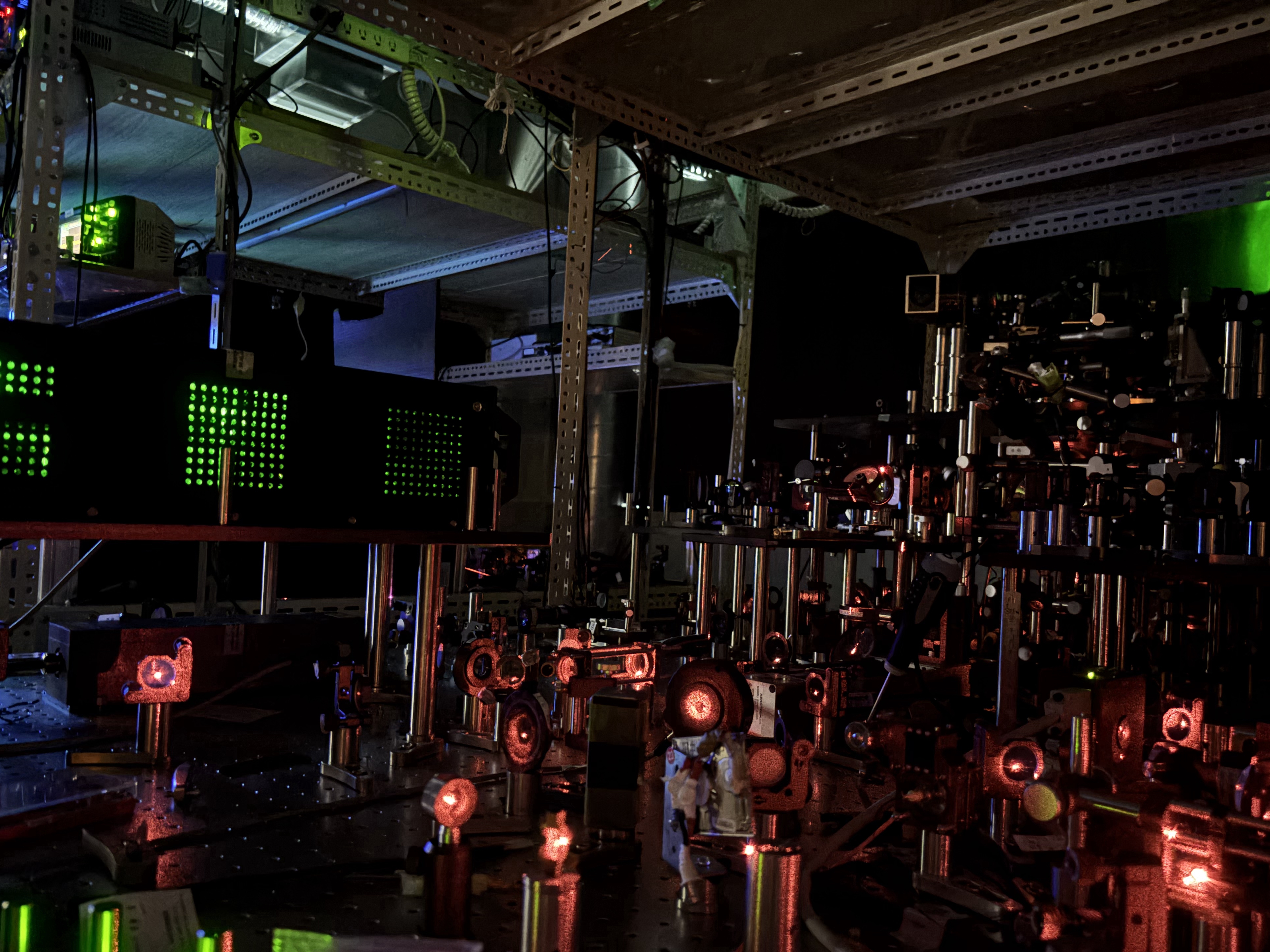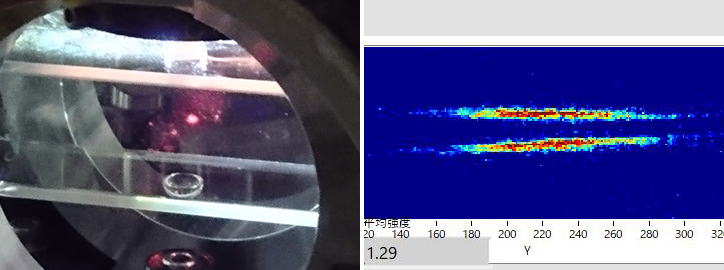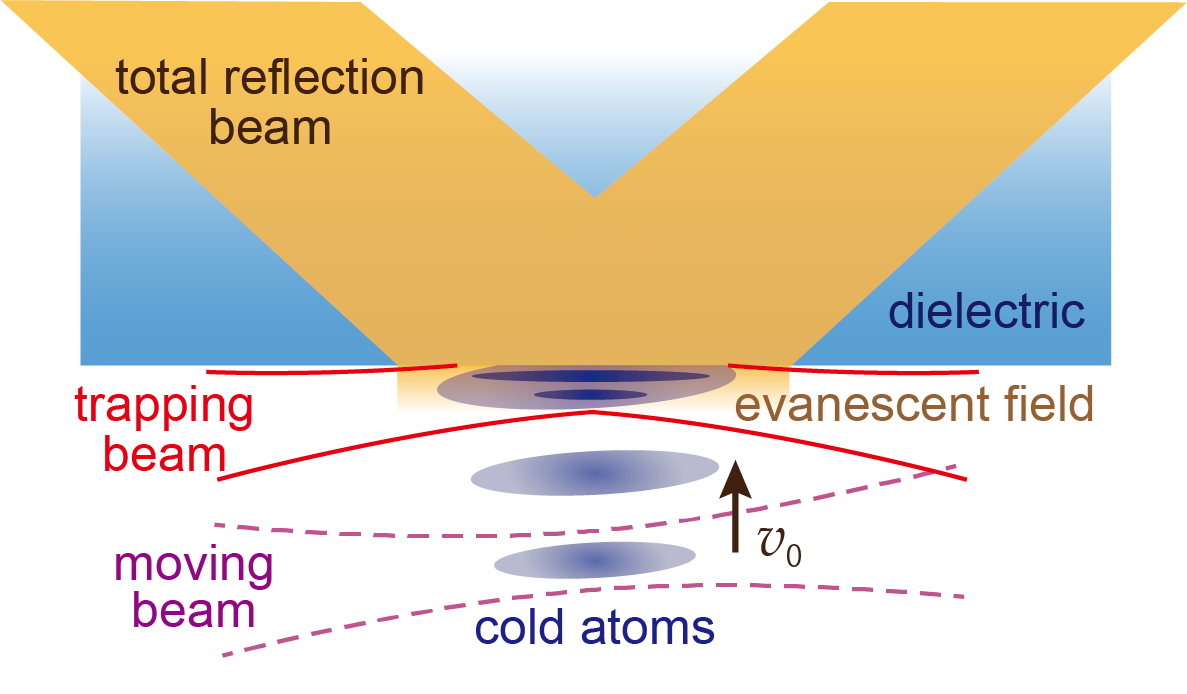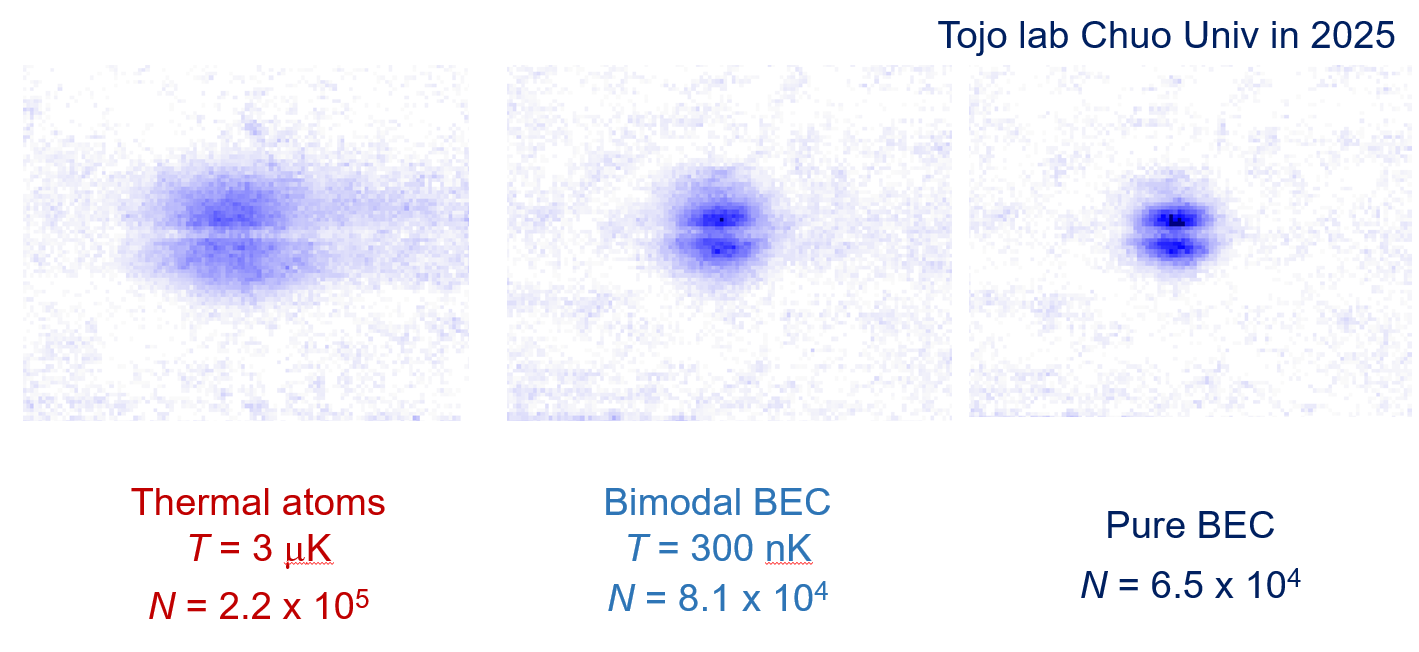Research
Our research
We study the interaction between light and atoms using precision spectroscopy
and quantum optics techniques. Quantum techniques have been developed to
precisely control the interaction between laser light and atoms, known
as quantum electronics. We are conducting research to discover new physical
phenomena and technological innovations by utilizing these cutting-edge
technologies.
Laser cooling techniques that minimize the spatial and momentum distributions of atomic ensembles have made remarkable progress, enabling the realization of ultra-low temperature states below 100 nK and the utilization of the matter-wave properties of atoms. We are utilizing this technology to generate Rb atomic cloud cooled to hundreds of nK using laser cooling and several other cooling methods.

Atoms cooled by laser to extremely low momenta (left photo) are held in a tiny space within a vacuum chamber by the dipole force of a light beam. We study the interaction between light or solid surfaces and cooled atoms confined in a localized space using this optical dipole force trap, known as optical tweezers. We are currently investigating the interaction between light and cooled atoms using a novel optical trap, and the interaction between cooled atoms transported near a glass surface by the optical trap and the glass surface itself (right figure). We are recently achieving the generation of Bose-Einstein condensation using an all-optical method employing only laser beams for trapping.
Exploring interactions between cold atoms and a dielectric surface
Cold atomic fountains are utilized for precise measurements of energy states due to its ability to decelerate cooled atoms launched by gravity to ultra-low speeds. In recent years, these methods have been primarily utilized in atomic clocks and atomic interferometers.We have utilized the cold atomic fountain as a sensor to explore in the vicinity of surfaces. This method involves the transportation of cooled atoms that have been manipulated by optical traps to the vicinity of a dielectric surface. The atoms are then released with an initial upward velocity, designated as v0. Subsequent to release, the atoms are subject to the gravitational potential acting downward. This enables them to remain in the vicinity of the surface for extended periods. The duration of this stay can be controlled by manipulating both the initial velocity and the initial position of the atoms.

In this study, the atomic fountain method is employed in conjunction with the further irradiation of the dielectric surface with total internal reflection light to generate an evanescent field. The evanescent light field has been utilized in the investigation of surface-atom interactions with absorbed atoms in the vicinity of the surface. This approach facilitates the exploration of the interaction between the launched cooled atoms and the dielectric surface. The internal state of the atoms is measured in relation to two distinct van der Waals potentials and one Casimir-Polder potential. The van der Waals potential is proportional to r -3, while the Casimir-Polder potential is proportional to r -4, where r is the distance from the dielectric surface.
For details, see Mashimo et al., arXiv:2511.08115.
All optical formation of Bose-Einstein condensate near glass surface
Precise manipulation of a quantum degenerate gas has the potential to facilitate quantum sensing, thereby enabling investigation of atomic surfaces. Interactions are attributed to their elevated sensitivity to electromagnetic fields, including van der Waals and Casimir-Polder potentials [1,2]. In addition, theoretical models suggest that, in the vicinity of a dielectric surface, transition probabilities of optically forbbiden transitions can be enhanced.Especially, the probabilities of higher-order electric multipole transitions are estimated to be increased by more than several orders of magnitude [3].
In this investigation, we have explored atom-surface interactions through the use of 87Rb F=1 Bose-Einstein condensate (BEC). Pre-cooled atoms are loaded into an optical dipole trap [4] and transported to a glass surface region [5]. The position of the focal point of the trapping light is adjusted vertically in standing waves formed by the incident and reflected trapping beams. Subsequent to the transportation process, the transported cold atoms are observed at a distance of 10 µm from the surface in initial. By the evaporative cooling process within the standing wave potential, the temperature of the atoms can be decreased below 1 µK. After considerable effort, we have ultimately achieved the successful optical formation of a Bose-Einstein condensate in proximity to a glass surface.

(in preparing to submit manuscript)
[1] Athanasios Laliotis, Bing-Sui Lu, Martial Ducloy, Daniel Bloch, and David Wilkowski, AVS Quantum Sci. 3, 043501 (2021).
[2] J. M. Obrecht, R. J. Wild, M. Antezza, L. P. Pitaevskii, S. Stringari, and E. A. Cornell, Phys. Rev. Lett. 98, 063201 (2007).
[3] Kosuke Shibata, Satoshi Tojo, and Daniel Bloch, Optics Express 25, 9476 (2017).
[4] Taro Mashimo, Masashi Abe, and Satoshi Tojo, Phys. Rev. A 100, 063426 (2019).
[5] Taro Mashimo, Masashi Abe, Athanasios Laliotis, and Satoshi Tojo, arXiv:2511.08115.
Hybrid trap with optical dipole and radiative forces
We investigated effective trapping techniques for cold Rb atoms using dipole and radiative forces in an optical trap. An optical trap that satisfies the near-optical resonance condition is comprised of not only the dipole force but also the radiative forces. Conversely, a trap that utilizes a far-off resonance exerts dominance over the dipole force alone. The spatial behaviors of the center-of-mass positions and the loading efficiencies of the trapped atoms in the near-optical resonant trap are measured by altering the detuning over the range of −0.373 to −2.23 THz from the D2 resonance.
The temporal variation in the spatial behavior of the trap suggests that the equilibrium condition between the optical dipole and the radiative forces is altered, thereby indicating the presence of suitable positions for stably holding atoms. The outcome is contingent upon the laser detuning of the trap. The stable position, which is not a primary position of focus in the Gaussian beam optics, depends exclusively on the laser detuning due to the change in the radiative force. It is independent of the change in the laser intensity, which results in a balance between the radiative and dipole forces.

For details, see Mashimo et al., Phys. Rev A 100, 063426 (2019).
Excitation enhancement in multipole transitions near nano-media
We investigate the enhancement of electric multipole excitations (E1: electric dipole, E2: electric quadrupole, E3: electric octupole excitations) of atoms in the vicinity of an object with a nanoscale edge resulting from a large electromagnetic field gradient. We calculated the excitation efficiencies of Alkali atoms around a nanoedge and found the excitations are enhanced by several orders of magnitude. The efficiencies with the change in the magnetic quantum number resolved are also examined. Each resolved efficiency displays a rotationally symmetric spatial distribution, with continuous modification in shape from the far field to the near field.
Figure shows two-dimensional plots of the excitation efficiencies of (a)–(c) E1, (d)–(f) E2, and(g)–(i) E3 transitions in the vicinities of nanostructures with curvatures of (a), (d), (g) radii of nano-structures R = 2 nm, (b), (e), (h) 10 nm, and (c), (f), (i) 50 nm, respectively.
For details, see Shibata et al., Optics Express 25, 9476 (2017).
Quantum Optics Lab (Tojo Lab) Dept. Physics, Faculty of Science and Engineering, Chuo University
1-13-27 Kasuga, Bunkyo, Tokyo 112-8551